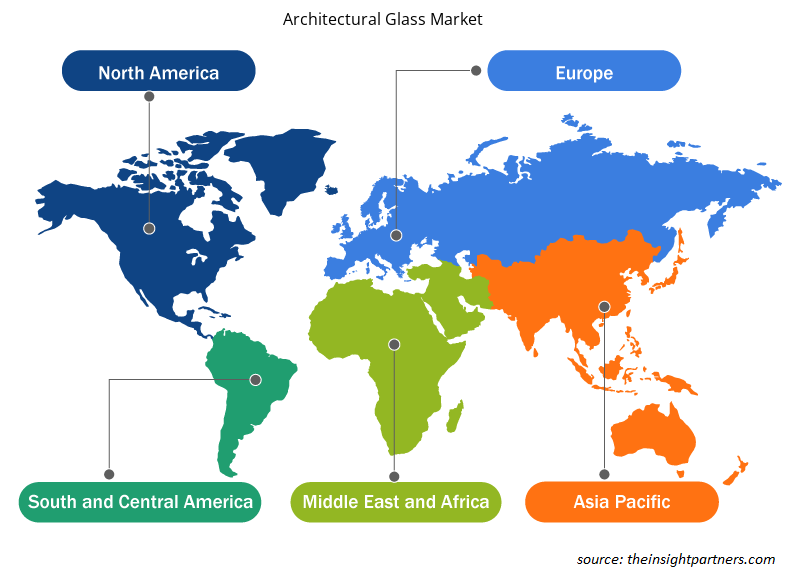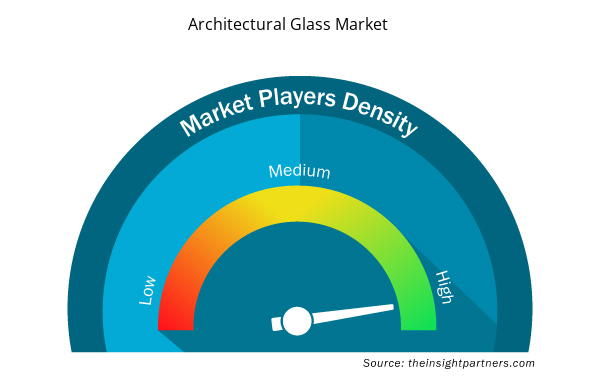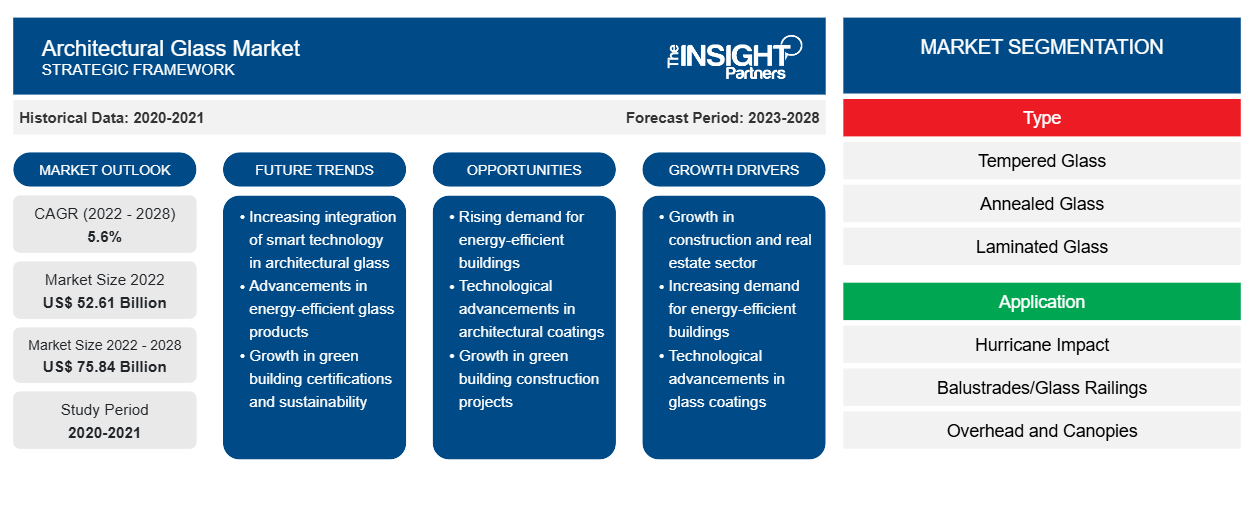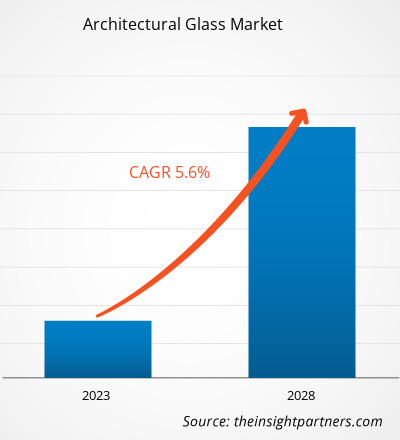Si prevede che il mercato del vetro architettonico crescerà da 52.608,27 milioni di dollari nel 2022 a 75.837,41 milioni di dollari entro il 2028; si prevede una crescita a un CAGR del 5,6% dal 2022 al 2028.
Il vetro architettonico è un materiale da costruzione utilizzato come materiale di vetratura trasparente in finestre, porte di case e uffici, pareti esterne, tra gli altri. La crescente urbanizzazione sta contribuendo alle crescenti attività di costruzione in tutto il mondo. La crescente crescita della popolazione, la migrazione di persone dalle aree rurali a quelle urbane per opportunità di carriera e gli investimenti aziendali strategici stanno stimolando il settore delle costruzioni, guidando la crescita del mercato del vetro architettonico .
Impatto della pandemia di COVID-19 sul mercato del vetro architettonico
Nel 2020, vari settori hanno dovuto rallentare le proprie attività a causa di interruzioni nelle catene di valore e di fornitura causate dalla chiusura dei confini nazionali e internazionali. La pandemia di COVID-19 ha avuto un impatto negativo sulle economie e sui settori a causa di lockdown, divieti di viaggio e chiusure aziendali. Le interruzioni nelle catene di fornitura di materie prime chiave e le irregolarità nei processi di produzione dovute alle restrizioni imposte dalle autorità governative hanno avuto un impatto diretto sul settore dei prodotti chimici e dei materiali, ostacolando la produzione e la domanda di materiali da costruzione. Questi fattori hanno avuto un impatto negativo sul mercato del vetro architettonico durante la pandemia di COVID-19. Tuttavia, nel 2021, il mercato ha assistito a una ripresa positiva poiché i governi hanno annunciato l'allentamento delle restrizioni precedentemente imposte. Ai produttori è stato consentito di lavorare a piena capacità, sfruttando la loro redditività. Si prevede che questo fattore guiderà il mercato nei prossimi anni. Ad esempio, secondo Eurostat, dopo un calo senza precedenti a marzo e aprile (-25,9%), l'attività edilizia nell'Unione europea è aumentata del 20,4% a maggio 2020. Ha recuperato alcune delle perdite della crisi. Da allora, l'attività edilizia è aumentata nella maggior parte dei mesi, ma non in modo molto dinamico. A gennaio 2022, il livello di produzione era solo dell'1,9% più alto rispetto a febbraio 2020.
Personalizza questo report in base alle tue esigenze
Riceverai la personalizzazione gratuita di qualsiasi report, comprese parti di questo report, o analisi a livello nazionale, pacchetto dati Excel, oltre a usufruire di grandi offerte e sconti per start-up e università
- Scopri le principali tendenze di mercato in questo rapporto.Questo campione GRATUITO includerà analisi di dati che spaziano dalle tendenze di mercato alle stime e alle previsioni.
Approfondimenti di mercato
Crescente domanda di vetro colorato e stampato
Con la crescita economica, l'aumento degli standard di vita e la modernizzazione della popolazione a livello globale, l'uso del vetro decorativo, come il vetro stampato e colorato, nella progettazione degli interni di edifici residenziali e commerciali è in aumento. La domanda di vetro serigrafato nel settore edile è in crescita poiché offre vari vantaggi estetici rispetto ai materiali da costruzione tradizionali. Il vetro serigrafato amplia i suoi utilizzi in applicazioni industriali, commerciali e architettoniche come vetrine, paesaggistica esterna di edifici, partizioni di spazi architettonici, vetro a mosaico, decorazione di mobili e altri oggetti 3D. Si prevede che tale progresso nelle varietà di produzione del vetro aumenterà ulteriormente la domanda di vetro architettonico.
Tipo Informazioni
In base al tipo, il mercato del vetro architettonico è suddiviso in vetro temperato , vetro ricotto, vetro laminato e altri. Si prevede che il segmento laminato registrerà il CAGR più elevato durante il periodo di previsione. Il vetro laminato è una buona alternativa al vetro tradizionale, in quanto offre una struttura rigida, robusta e durevole e fornisce uno strato solido e trasparente. Viene utilizzato in edifici ad alto rischio di uragani o altri disastri naturali, in finestre di edifici residenziali e commerciali ad alto rischio di effrazioni, in vetrine per oggetti di valore come gioielli, acquari o recinti per animali, pavimenti in vetro, scale in vetro, lucernari e tetti in vetro. Inoltre, a causa della crescente domanda di sicurezza, riduzione del rumore, resistenza alla rottura e protezione da condizioni meteorologiche avverse, si prevede che il mercato assisterà a una crescita costante durante il periodo di previsione.
Approfondimenti sulle applicazioni
In base all'applicazione, il mercato del vetro architettonico è segmentato in vetro antiuragano, balaustre/ringhiere in vetro, pensiline e pensiline, vetro di sicurezza/antiproiettile, acustico, vetro decorativo/colorato, facciate strutturali e altri. Il segmento delle facciate strutturali ha detenuto la quota maggiore del mercato nel 2021. Nelle facciate strutturali , il vetro architettonico è ampiamente utilizzato nei rivestimenti di pareti in vetro e nelle pareti divisorie in vetro. Il rivestimento delle pareti è utilizzato per fornire un certo grado di isolamento termico e resistenza alle intemperie e per migliorare l'aspetto degli edifici. Il rivestimento in vetro è una tecnica ampiamente utilizzata in architettura in cui i pannelli di vetro vengono utilizzati sulla superficie esterna degli edifici. Il vetro temperato è il tipo di vetro più comune utilizzato nelle pareti divisorie. Questo vetro viene temperato riscaldandolo, il che lo rende da quattro a cinque volte più resistente e durevole del vetro ricotto. Si prevede che questi fattori guideranno il segmento.
I principali attori che operano nel mercato del vetro architettonico includono AGC Inc, Compagnie de Saint-Gobain SA, Guardian Industries Holdings LLC, Nippon Sheet Glass Co Ltd, Qingdao Morn Building Materials Co Ltd, Asahi India Glass Ltd, Turkiye Sise ve Cam Fabrikalari AS, Schott AG, Jinjing (Group) Co Ltd e Vitro SAB de CV. Questi attori si concentrano sulla fornitura di prodotti di alta qualità per soddisfare le richieste dei clienti. Si concentrano anche su strategie come investimenti in attività di ricerca e sviluppo e lanci di nuovi prodotti.
Approfondimenti regionali sul mercato del vetro architettonico
Le tendenze regionali e i fattori che influenzano il mercato del vetro architettonico durante il periodo di previsione sono stati ampiamente spiegati dagli analisti di Insight Partners. Questa sezione discute anche i segmenti e la geografia del mercato del vetro architettonico in Nord America, Europa, Asia Pacifico, Medio Oriente e Africa e America meridionale e centrale.

- Ottieni i dati specifici regionali per il mercato del vetro architettonico
Ambito del rapporto sul mercato del vetro architettonico
| Attributo del report | Dettagli |
|---|---|
| Dimensioni del mercato nel 2022 | 52,61 miliardi di dollari USA |
| Dimensioni del mercato entro il 2028 | 75,84 miliardi di dollari USA |
| CAGR globale (2022 - 2028) | 5,6% |
| Dati storici | 2020-2021 |
| Periodo di previsione | 2023-2028 |
| Segmenti coperti | Per tipo
|
| Regioni e Paesi coperti | America del Nord
|
| Leader di mercato e profili aziendali chiave |
|
Densità degli attori del mercato del vetro architettonico: comprendere il suo impatto sulle dinamiche aziendali
Il mercato del vetro architettonico sta crescendo rapidamente, spinto dalla crescente domanda degli utenti finali dovuta a fattori quali l'evoluzione delle preferenze dei consumatori, i progressi tecnologici e una maggiore consapevolezza dei vantaggi del prodotto. Con l'aumento della domanda, le aziende stanno ampliando le loro offerte, innovando per soddisfare le esigenze dei consumatori e capitalizzando sulle tendenze emergenti, il che alimenta ulteriormente la crescita del mercato.
La densità degli operatori di mercato si riferisce alla distribuzione di aziende o società che operano in un particolare mercato o settore. Indica quanti concorrenti (operatori di mercato) sono presenti in un dato spazio di mercato in relazione alle sue dimensioni o al valore di mercato totale.
Le principali aziende che operano nel mercato del vetro architettonico sono:
- AGC Inc
- Compagnia di Saint-Gobain SA
- Società a responsabilità limitata Guardian Industries Holdings LLC
- Nippon Sheet Glass Co Ltd
- Materiali edili Qingdao Morn Co Ltd
Disclaimer : le aziende elencate sopra non sono classificate secondo un ordine particolare.

- Ottieni una panoramica dei principali attori del mercato del vetro architettonico
Segnala i riflettori
- Tendenze industriali progressive nel mercato del vetro architettonico per aiutare gli operatori a sviluppare strategie efficaci a lungo termine
- Strategie di crescita aziendale adottate dalle aziende per garantire la crescita nei mercati sviluppati e in via di sviluppo
- Analisi quantitativa del mercato del vetro architettonico dal 2020 al 2028
- Stima della domanda globale di vetro architettonico
- Analisi delle cinque forze di Porter per illustrare l'efficacia degli acquirenti e dei fornitori di vetro architettonico
- Sviluppi recenti per comprendere lo scenario competitivo del mercato
- Tendenze e prospettive del mercato, insieme ai fattori che guidano e frenano la crescita del mercato del vetro architettonico
- Assistenza nel processo decisionale evidenziando le strategie di mercato che sostengono l'interesse commerciale
- La dimensione del mercato del vetro architettonico nei vari nodi
- Panoramica dettagliata e segmentazione del mercato, nonché dinamiche del settore delle costruzioni
- Dimensioni del mercato del vetro architettonico in varie regioni con promettenti opportunità di crescita
Profili aziendali
- AGC Inc
- Compagnia di Saint-Gobain SA
- Società a responsabilità limitata Guardian Industries Holdings LLC
- Nippon Sheet Glass Co Ltd
- Materiali edili Qingdao Morn Co Ltd
- Vetro Asahi India Ltd
- Turkiye Sise ve Cam Fabrikalari AS
- Azienda Schott
- Jinjing (gruppo) Co Ltd
- Vitro SAB di CV
- Analisi storica (2 anni), anno base, previsione (7 anni) con CAGR
- Analisi PEST e SWOT
- Valore/volume delle dimensioni del mercato - Globale, regionale, nazionale
- Industria e panorama competitivo
- Set di dati Excel



Report Coverage
Revenue forecast, Company Analysis, Industry landscape, Growth factors, and Trends

Segment Covered
This text is related
to segments covered.

Regional Scope
North America, Europe, Asia Pacific, Middle East & Africa, South & Central America

Country Scope
This text is related
to country scope.
Domande frequenti
Based on application, acoustics is the fastest-growing segment in the architectural glass market.
The increase in construction and infrastructural redevelopment activities and rise in consumer expenditure on interior designing are some of the key driving factors for the architectural glass market.
Asia Pacific accounted for the largest share of the global architectural glass market owing to the growing expansion of the real estate industry, rising investments in the construction sector, and rise in sustainable construction in the region.
Based on the type, the laminated glass segment accounted for the largest revenue share as it is often used as hurricane-resistant walls, intrusion cover in houses, and damage intolerance in vehicle windshields.
The global architectural glass market is growing with an upward trend, and manufacturers are making significant investments in research & development, partnerships, and collaborations to launch innovative products to tap into emerging market opportunities.
The major players operating in the global architectural glass market are AGC Inc, Compagnie de Saint-Gobain SA, Guardian Industries Holdings LLC, Nippon Sheet Glass Co Ltd, Qingdao Morn Building Materials Co Ltd, Asahi India Glass Ltd, Turkiye Sise ve Cam Fabrikalari AS, Schott AG, Jinjing (Group) Co Ltd, and Vitro SAB de CV among few others.
Trends and growth analysis reports related to Chemicals and Materials : READ MORE..
The List of Companies - Architectural Glass Market
- AGC Inc
- Compagnie de Saint-Gobain SA
- Guardian Industries Holdings LLC
- Nippon Sheet Glass Co Ltd
- Qingdao Morn Building Materials Co Ltd
- Asahi India Glass Ltd
- Turkiye Sise ve Cam Fabrikalari AS
- Schott AG
- Jinjing (Group) Co Ltd
- Vitro SAB de CV
The Insight Partners performs research in 4 major stages: Data Collection & Secondary Research, Primary Research, Data Analysis and Data Triangulation & Final Review.
- Data Collection and Secondary Research:
As a market research and consulting firm operating from a decade, we have published and advised several client across the globe. First step for any study will start with an assessment of currently available data and insights from existing reports. Further, historical and current market information is collected from Investor Presentations, Annual Reports, SEC Filings, etc., and other information related to company’s performance and market positioning are gathered from Paid Databases (Factiva, Hoovers, and Reuters) and various other publications available in public domain.
Several associations trade associates, technical forums, institutes, societies and organization are accessed to gain technical as well as market related insights through their publications such as research papers, blogs and press releases related to the studies are referred to get cues about the market. Further, white papers, journals, magazines, and other news articles published in last 3 years are scrutinized and analyzed to understand the current market trends.
- Primary Research:
The primarily interview analysis comprise of data obtained from industry participants interview and answers to survey questions gathered by in-house primary team.
For primary research, interviews are conducted with industry experts/CEOs/Marketing Managers/VPs/Subject Matter Experts from both demand and supply side to get a 360-degree view of the market. The primary team conducts several interviews based on the complexity of the markets to understand the various market trends and dynamics which makes research more credible and precise.
A typical research interview fulfils the following functions:
- Provides first-hand information on the market size, market trends, growth trends, competitive landscape, and outlook
- Validates and strengthens in-house secondary research findings
- Develops the analysis team’s expertise and market understanding
Primary research involves email interactions and telephone interviews for each market, category, segment, and sub-segment across geographies. The participants who typically take part in such a process include, but are not limited to:
- Industry participants: VPs, business development managers, market intelligence managers and national sales managers
- Outside experts: Valuation experts, research analysts and key opinion leaders specializing in the electronics and semiconductor industry.
Below is the breakup of our primary respondents by company, designation, and region:

Once we receive the confirmation from primary research sources or primary respondents, we finalize the base year market estimation and forecast the data as per the macroeconomic and microeconomic factors assessed during data collection.
- Data Analysis:
Once data is validated through both secondary as well as primary respondents, we finalize the market estimations by hypothesis formulation and factor analysis at regional and country level.
- Macro-Economic Factor Analysis:
We analyse macroeconomic indicators such the gross domestic product (GDP), increase in the demand for goods and services across industries, technological advancement, regional economic growth, governmental policies, the influence of COVID-19, PEST analysis, and other aspects. This analysis aids in setting benchmarks for various nations/regions and approximating market splits. Additionally, the general trend of the aforementioned components aid in determining the market's development possibilities.
- Country Level Data:
Various factors that are especially aligned to the country are taken into account to determine the market size for a certain area and country, including the presence of vendors, such as headquarters and offices, the country's GDP, demand patterns, and industry growth. To comprehend the market dynamics for the nation, a number of growth variables, inhibitors, application areas, and current market trends are researched. The aforementioned elements aid in determining the country's overall market's growth potential.
- Company Profile:
The “Table of Contents” is formulated by listing and analyzing more than 25 - 30 companies operating in the market ecosystem across geographies. However, we profile only 10 companies as a standard practice in our syndicate reports. These 10 companies comprise leading, emerging, and regional players. Nonetheless, our analysis is not restricted to the 10 listed companies, we also analyze other companies present in the market to develop a holistic view and understand the prevailing trends. The “Company Profiles” section in the report covers key facts, business description, products & services, financial information, SWOT analysis, and key developments. The financial information presented is extracted from the annual reports and official documents of the publicly listed companies. Upon collecting the information for the sections of respective companies, we verify them via various primary sources and then compile the data in respective company profiles. The company level information helps us in deriving the base number as well as in forecasting the market size.
- Developing Base Number:
Aggregation of sales statistics (2020-2022) and macro-economic factor, and other secondary and primary research insights are utilized to arrive at base number and related market shares for 2022. The data gaps are identified in this step and relevant market data is analyzed, collected from paid primary interviews or databases. On finalizing the base year market size, forecasts are developed on the basis of macro-economic, industry and market growth factors and company level analysis.
- Data Triangulation and Final Review:
The market findings and base year market size calculations are validated from supply as well as demand side. Demand side validations are based on macro-economic factor analysis and benchmarks for respective regions and countries. In case of supply side validations, revenues of major companies are estimated (in case not available) based on industry benchmark, approximate number of employees, product portfolio, and primary interviews revenues are gathered. Further revenue from target product/service segment is assessed to avoid overshooting of market statistics. In case of heavy deviations between supply and demand side values, all thes steps are repeated to achieve synchronization.
We follow an iterative model, wherein we share our research findings with Subject Matter Experts (SME’s) and Key Opinion Leaders (KOLs) until consensus view of the market is not formulated – this model negates any drastic deviation in the opinions of experts. Only validated and universally acceptable research findings are quoted in our reports.
We have important check points that we use to validate our research findings – which we call – data triangulation, where we validate the information, we generate from secondary sources with primary interviews and then we re-validate with our internal data bases and Subject matter experts. This comprehensive model enables us to deliver high quality, reliable data in shortest possible time.


 Ottieni un campione gratuito per questo repot
Ottieni un campione gratuito per questo repot